Comparison of the Shutdown Transitions of the Full-Flow Pump and Axial-Flow Pump
Abstract
:1. Introduction
2. Numerical Simulation
2.1. Computational Models and Grids
2.2. Control Equations
2.3. Algorithm Implementation
2.4. Boundary Conditions and Calculation Settings
3. Model Test
3.1. Introduction to the Test Bench
3.2. Verification of the Accuracy of the Calculation
3.2.1. Verification of External Characteristics
3.2.2. Verification of Transient Characteristics
4. Results and Discussion
4.1. Steady Characteristics
4.2. External Characteristics
4.3. Vortex Identification
4.4. Entropy Production
5. Conclusions
- (1)
- Same rules for the AFP and FFP: During the shutdown transition, the two pumps experience a pumping state, braking state, turbine state, and runaway state, with the braking state being of the smallest proportion; each external characteristic of the AFP and FFP (speed, flow, torque, and axial and radial forces) follows the same trend; the rotational speed and flow rate of the two pumps gradually change from forward to reverse; the rotor radial force first decreases and then increases until it enters the turbine state and gradually stabilizes; the axial force decreases continuously, increases only slightly in the braking state, and finally stabilizes in the runaway state; the high-EPR area within the two pumps gradually shifts toward the IGV, and the high-EPR area first decreases and then increases; the hydraulic losses of the AFP and FFP units under the braking state are the lowest. Both pumps’ high-EPR regions are mainly concentrated in the inlet channels, IGVs, and impellers.
- (2)
- Different rules for the AFP and FFP: During the shutdown transition, the rates of decrease in torque, speed, and flow of the AFP are faster than those of the FFP, which means that the AFP is faster than the FFP. Due to the clearance backflow, the impeller of the FFP generates clearance backflow vortices near the I&O, and the overall flow pattern in the impeller is worse than that of the AFP, resulting in a greater hydraulic loss than that in the AFP. Under the runaway state, the hydraulic loss of the FFP is approximately 4.06 times that of the AFP. The AFP’s runaway speed and flow rate are greater than the FFP’s. During the shutdown transition, the axial force of the AFP is significantly lower than that of the FFP. The maximum rotor radial force of the AFP is approximately 1.14 times that of the FFP. In the pumping state, due to the effect of clearance backflow, the axial velocity of about 10% of the impeller inlet area near the FFP shroud is significantly lower than that of the AFP. In the turbine state, the axial velocity values at the impeller inlet and outlet of the AFP are 1.36 and 1.59 times higher than those of the FFP, respectively.
Author Contributions
Funding
Institutional Review Board Statement
Informed Consent Statement
Data Availability Statement
Conflicts of Interest
Nomenclature
| A: The symmetry tensor |
| B: The anti-symmetry tensor |
| Cp: Pressure pulsation coefficient |
| d1: The tip clearance of the AFP, mm |
| d2: The stator and rotor clearance of the FFP, mm |
| dt: Single time step |
| D1: The radii of the impeller hub, mm |
| D2: The radii of the impeller shroud, mm |
| f: Frequency, Hz |
| Fz: Axial force, N |
| Fr: Radial force, N |
| H: Head, m |
| Hc: Head coefficient |
| Hd: Design head, m |
| JG: The rotational inertia of the rotating parts of the pump unit, kg/m2 |
| k: The turbulent energy, m2/s2 |
| n: Impeller revolution, rpm |
| nr: Speed of rotation of the runaway, rpm |
| Nt: Number of steps in one revolution of the impeller |
| p: Pressure, Pa |
| P: Instantaneous pressure, Pa |
| PL: Energy loss, W |
| Q: Mass Flow rate, kg/s |
| Qc: Flow coefficient |
| Qd: Design flow, kg/s |
| Qr: Runaway flow, kg/s |
| Qt: SRC backflow, kg/s |
| R: The rotating part vortex |
| (R × S − V): The non-rotating part vortex |
| Sz: The direct dissipative entropy production, W ∗ K−1 |
| St: The turbulent dissipative entropy production, W ∗ K−1 |
| Sb: The wall entropy production, W ∗ K−1 |
| S: The total entropy production, W ∗ K−1 |
| : The direct dissipative entropy production rate, W ∗ m−3 ∗ K−1 |
| : The turbulent dissipative entropy production rate, W ∗ m−3 ∗ K−1 |
| : The wall entropy production rate, W ∗ m−3 ∗ K−1 |
| t: The time, s |
| ta, tf: The time when the radial force of the AFP and FFP reaches the maximum value, s |
| T: The temperature, K |
| TD: The dragging torque of the motor, N·m |
| TF: The loss torque of the motor fan, N·m |
| TI: The torque of inertia, N·m |
| TO: The oil viscous resistance torque of the thrust head and slip rotor, N·m |
| TR: The frictional torque of the radial bearing, N·m |
| TW: The water torque of the pump, N·m |
| TZ: The frictional torque of the thrust bearing, N·m |
| u: Circumferential velocity, m/s |
| : The average velocity vector at the center of the first grid layer in the near-wall zone, m/s |
| Va: Axial velocity, m/s |
| V: The rotating part vortex |
| Greek letters and mathematical operators |
| β: Empirical coefficient |
| η: Efficiency, % |
| : The turbulent dynamic viscosity, Pa·s |
| ρ: Liquid density, kg/m3 |
| ω: The instantaneous angular speed of the impeller, rad/s |
| Ω: The ratio of R to ω |
| ΔCp: The maximum difference of the pressure pulsation coefficient |
| Δh: Head difference, Pa |
| : Average pressure, Pa |
| Δnr: The maximum difference of the runaway speed, rpm |
| , , and : The components of the mean velocity in the x, y, and z directions, m/s |
| , , and : The pulsation velocity components in the x, y, and z directions, m/s |
| ω: Total vortex |
| Abbreviations |
| 2D: Two-dimensional |
| 3D: Three-dimensional |
| AFP: Axial-flow pump |
| BPF: Blade passing frequency |
| CFD: Computational fluid dynamics |
| EP: Entropy production |
| EPR: Entropy production rate |
| FFP: Full-flow pump |
| GV: Guide vane |
| IGV: Inlet guide vane |
| I&O: Inlet and outlet |
| LE: Leading edge |
| PP: Pressure pulsation |
| PS: Pressure side |
| SRC: Stator rotor clearance |
| SS: Suction side |
| SUT: Start-up transition |
| TE: Trailing edge |
| UDF: User-Defined Function |
References
- Tang, F.; Liu, C.; Zhou, J.; Yuan, J.; Cheng, L.; Yan, B.; Xie, W. “S” shaped hydrofoil bi-directional axial-flow pump design. Pump Technol. 2002, 5, 11–13. [Google Scholar]
- Liu, H.; Guo, Q.; Shi, L.; Tang, F.; Dai, L.; Shen, J.; Liu, J. Lift-drag characteristics of S-shaped hydrofoil under different cloud cavitation conditions. Ocean Eng. 2023, 278, 114374. [Google Scholar] [CrossRef]
- Liu, Y.; Zhe, H.; Xue, Y.; Tan, J.; Yuan, P.; Zhang, Q. Effects of vortex generator on the hydrodynamic characteristics of hydrofoil and horizontal axis tidal turbine. Phys. Fluids 2023, 35, 035104. [Google Scholar] [CrossRef]
- Zang, W.; Zhang, Y.; Zheng, Y.; Zhang, J.; Guan, D.W.; Fernandez-Rodriguez, E. On the impact of waves and turbulence on the power fluctuations and wake structure of a tidal-stream turbine. Phys. Fluids 2023, 35, 055115. [Google Scholar]
- Derakhshan, S.; Ashoori, M.; Salemi, A. Experimental and numerical study of a vertical axis tidal turbine performance. Ocean Eng. 2017, 137, 59–67. [Google Scholar] [CrossRef]
- Abonai, C.; Xi, J. Operation and management experience of Lance tidal power plant in France. Express Water Resour. Hydropower Inf. 2011, 32, 29–32. (In Chinese) [Google Scholar] [CrossRef]
- Wang, Z.; Yang, X.; Xiao, Y. Hydraulic performance optimization of bidirectional tidal power turbine. J. Drain. Irrig. Mach. Eng. 2010, 28, 417–421. (In Chinese) [Google Scholar]
- Meng, F.; Li, Y.; Pei, J. Energy Characteristics of Full Tubular Pump Device with Different Backflow Clearances Based on Entropy Production. Appl. Sci. 2021, 11, 3376. [Google Scholar] [CrossRef]
- Shi, L.; Yuan, Y.; Jiao, H.; Tang, F.; Cheng, L.; Yang, F.; Jin, Y.; Zhu, J. Numerical investigation and experiment on pressure pulsation characteristics in a full tubular pump. Renew. Energy 2021, 163, 987–1000. [Google Scholar] [CrossRef]
- Shi, L.; Zhang, W.; Jiao, H.; Tang, F.; Wang, L.; Sun, D.; Shi, W. Numerical simulation and experimental study on the comparison of the hydraulic characteristics of an axial-flow pump and a full tubular pump. Renew. Energy 2020, 153, 1455–1464. [Google Scholar] [CrossRef]
- Shi, L.; Zhu, J.; Yuan, Y.; Tang, F.; Huang, P.; Zhang, W.; Liu, H.; Zhang, X. Numerical Simulation and Experiment of the Effects of Blade Angle Deviation on the Hydraulic Characteristics and Pressure Pulsation of an Axial-Flow Pump. Shock. Vib. 2021, 2021, 6673002. [Google Scholar] [CrossRef]
- Liu, J.; Li, Z.; Wang, L.; Jiao, L. Numerical Simulation of the Transient Flow in a Radial Flow Pump during Stopping Period. J. Fluids Eng. 2011, 133, 111101. [Google Scholar] [CrossRef]
- Wu, D.; Wu, P.; Yang, S.; Wang, L. Transient Characteristics of a Closed-Loop Pipe System During Pump Stopping Periods. J. Press. Vessel Technol. 2014, 136, 021301. [Google Scholar] [CrossRef]
- Zhang, X.; Hu, C.; Tang, F.; Yang, F.; Song, X.; Liu, C.; Shi, L. Numerical and Experimental Study on the Shutdown Transition Process of a Large Axial Flow Pump System Focusing on the Influence of Gate Control. J. Mar. Sci. Eng. 2023, 11, 280. [Google Scholar] [CrossRef]
- Liu, Y.; Zhou, J.; Zhou, D. Transient flow analysis in axial-flow pump system during stoppage. Adv. Mech. Eng. 2017, 9, 1687814017723280. [Google Scholar] [CrossRef]
- Su, W.; Li, X.; Xia, Y.; Liu, Q.; Binama, M.; Zhang, Y. Pressure fluctuation characteristics of a model pump-turbine during runaway transient. Renew. Energy 2021, 163, 517–529. [Google Scholar] [CrossRef]
- Trivedi, C.; Cervantes, M.; Gandhi, B.; Ole, F.D. Experimental investigations of transient pressure variations in a high head model Francis turbine during start-up and shutdown. J. Hydrodyn. 2014, 26, 277–290. [Google Scholar] [CrossRef]
- Deng, Y.; Xu, J.; Li, Y.; Zhang, Y.; Kuang, C. Research on Energy Loss Characteristics of Pump-Turbine during Abnormal Shutdown. Processes 2022, 10, 1628. [Google Scholar] [CrossRef]
- Zhang, Y.; Ji, Y.; Zhao, Y. Deep analysis of the transient behavior of centrifugal pumps during startup and shutdown. Meas. Control. 2022, 55, 155–163. [Google Scholar] [CrossRef]
- Feng, J.; Ge, Z.; Zhang, Y.; Zhu, G.; Wu, G.; Lu, J.; Luo, X. Numerical investigation on characteristics of transient process in centrifugal pumps during power failure. Renew. Energy 2021, 170, 267–276. [Google Scholar] [CrossRef]
- Li, X.; Tang, X.; Zhu, M.; Shi, X. 1D-3D coupling investigation of hydraulic transient for power-supply failure of centrifugal pump-pipe system. J. Hydroinformatics 2019, 21, 708–726. [Google Scholar] [CrossRef]
- Tanaka, T.; Tsukamoto, H. Transient Behavior of a Cavitating Centrifugal Pump at Rapid Change in Operating Conditions—Part 2: Transient Phenomena at Pump Startup/Shutdown. J. Fluids Eng. 1999, 121, 850–856. [Google Scholar] [CrossRef]
- Tsukamoto, H.; Matsunaga, S.; Yoneda, H.; Hata, S. Transient Characteristics of a Centrifugal Pump During Stopping Period. J. Fluids Eng. 1986, 108, 392–399. [Google Scholar] [CrossRef]
- Zhang, Y.; Zhu, Z.; Li, W.; Xiao, J. Effects of viscosity on transient behavior of a low specific speed centrifugal pump in starting and stopping periods. Int. J. Fluid Mech. Res. 2018, 45, 1–20. [Google Scholar] [CrossRef]
- Kan, K.; Zheng, Y.; Chen, H.; Zhou, D.; Dai, J.; Binama, M.; Yu, A. Numerical simulation of transient flow in a shaft extension tubular pump unit during runaway process caused by power failure. Renew. Energy 2020, 154, 1153–1164. [Google Scholar] [CrossRef]
- Kan, K.; Chen, H.; Zheng, Y.; Zhou, D.; Binama, M.; Dai, J. Transient characteristics during power-off process in a shaft extension tubular pump by using a suitable numerical model. Renew. Energy 2021, 164, 109–121. [Google Scholar] [CrossRef]
- Li, Z.; Bi, H.; Karney, B.; Wang, Z.; Yao, Z. Three-dimensional transient simulation of a prototype pump-turbine during normal turbine shutdown. J. Hydraul. Res. 2017, 55, 520–537. [Google Scholar] [CrossRef]
- Ge, Z.; Feng, J.; Wu, Y.; Yang, Z.; Zhang, Y.; Zhu, G.; Luo, X. Numerical analysis on characteristics of transient process in centrifugal pumps during power failure under large flow initial condition. Chin. J. Hydrodyn. 2022, 37, 452–458. (In Chinese) [Google Scholar] [CrossRef]
- Zhang, Y.; Zhu, Z.; Li, W.; Jia, X. Non-inertial stopping characteristics of a prototype pump. Adv. Mech. Eng. 2019, 11, 1687814019844649. [Google Scholar] [CrossRef]
- Chen, S.; Jiang, H.; Zhou, Z.; He, Z.; Yan, D. Study on start-up transient process simulation of large scale tubular pumping stations. J. Yangzhou Univ. Nat. Sci. Ed. 2009, 12, 74–78. (In Chinese) [Google Scholar] [CrossRef]
- Liu, M.; Han, Y.; Tan, L.; Lu, Y.; Ma, C.; Gou, J. Theoretical prediction model of transient performance for a mixed flow pump under fast start-up conditions. J. Energy Storage 2023, 68, 107678. [Google Scholar] [CrossRef]
- Jin, F.; Luo, Y.; Bi, H.; Wang, H.; Wang, Z.; Lin, K.; Lei, X.; Yang, X. Transient simulation of reversible pump turbine during pump mode’s starting up. Phys. Fluids 2023, 35, 025125. [Google Scholar] [CrossRef]
- Long, Y.; Lin, B.; Fang, J.; Zhu, R.; Q. Fu. Research on the Transient Hydraulic Characteristics of Multistage Centrifugal Pump During Start-Up Process. Front. Energy Res. 2020, 8, 76. [Google Scholar] [CrossRef]
- Li, Z.; Wu, P.; Wu, D.; Wang, L. Experimental and numerical study of transient flow in a centrifugal pump during startup. J. Mech. Sci. Technol. 2011, 25, 749–757. [Google Scholar] [CrossRef]
- Fu, S.; Zheng, Y.; Kan, K.; Chen, H.; Han, X.; Liang, X.; Liu, H.; Tian, X. Numerical simulation and experimental study of transient characteristics in an axial flow pump during start-up. Renew. Energy 2020, 146, 1879–1887. [Google Scholar] [CrossRef]
- Li, Q.; Ma, X.; Wu, P.; Yang, S.; Huang, B.; Wu, D. Study on the Transient Characteristics of the Centrifugal Pump during the Startup Period with Assisted Valve. Processes 2020, 8, 1241. [Google Scholar] [CrossRef]
- Wang, Y.; Xie, L.; Chen, J.; Liu, H.; Luo, K.; Liu, Z.; Cao, M. Experimental Study on Transient Startup Characteristics of a Super Low Specific Speed Centrifugal Pump. J. Chem. Eng. Jpn. 2019, 52, 743–750. [Google Scholar] [CrossRef]
- Shi, L.; Chai, Y.; Wang, L.; Xu, T.; Jiang, Y.; Xing, J.; Yan, B.; Chen, Y.; Han, Y. Numerical simulation and model test of the influence of guide vane angle on the performance of axial flow pump. Phys. Fluids 2023, 35, 015129. [Google Scholar] [CrossRef]
- Liu, J.; Zheng, Y.; Zhou, D.; Mao, Y.; Zhang, L. Analysis of Basic Flow Pattern in Shaft Front-positioned and Shaft Rear-positioned Tubular Pump Systems. J. Agric. Mach. 2010, 41, 32–38. (In Chinese) [Google Scholar]
- Deng, E.; Yue, H.; Ni, Y.; Wang, Y.; Xu, X.; Chen, Z. A turbulent crosswind simulation method at high-speed railway tunnel entrance: Based on field test and geometric turbulence generator. Phys. Fluids 2023, 35, 015156. [Google Scholar] [CrossRef]
- Zhang, D.; Wu, S.; Shi, W.; Pan, D.; Yao, J.; Zhang, G. Application and experiment of different turbulence models for simulating tip leakage vortex in axial flow pump. Trans. Chin. Soc. Agric. Eng. 2013, 29, 46–53. (In Chinese) [Google Scholar] [CrossRef]
- Menter, F. Review of the shear-stress transport turbulence model experience from an industrial perspective. Int. J. Comput. Fluid Dyn. 2009, 23, 305–316. [Google Scholar] [CrossRef]
- Deng, E.; Yue, H.; Ni, Y.; He, X.; Yang, W.; Chen, Z. Wake dynamic characteristics of windproof structures in embankment–bridge sections along a high-speed railway under natural strong crosswinds. Phys. Fluids 2023, 35, 055109. [Google Scholar]
- Kan, K.; Zhang, Q.; Xu, Z.; Chen, H.; Zheng, Y.; Zhou, D.; Binama, M. Study on a horizontal axial flow pump during runaway process with bidirectional operating conditions. Sci. Rep. 2021, 11, 21834. [Google Scholar] [CrossRef] [PubMed]
- Chai, B.; Yang, J.; Wang, X.; Jiang, B. Pressure Fluctuation Characteristics Analysis of Centrifugal Pump as Turbine in Its Start-Up Process. Actuators 2022, 11, 132. [Google Scholar] [CrossRef]
- Chen, S.; He, Z.; Zhou, Z.; Pan, G.; Yan, D. Study on transient process of low water-head large pumping station while pumping off. J. Hydroelectr. Eng. 2007, 5, 128–133. (In Chinese) [Google Scholar]
- Jiao, H.; Chen, S.; Wang, M.; Liu, H. Comparison of transient characteristics of positive and negative power-off transition process of “S” shaped bi-directional full-flow pump. Phys. Fluids 2023, 35, 065113. [Google Scholar] [CrossRef]
- Kan, K.; Xu, Z.; Chen, H.; Xu, H.; Zheng, Y.; Zhou, D.; Muhirwa, A.; Binama, B. Energy loss mechanisms of transition from pump mode to turbine mode of an axial-flow pump under bidirectional conditions. Energy 2022, 257, 124630. [Google Scholar] [CrossRef]
- Yang, F.; Hu, W.; Li, C.; Liu, C.; Jin, Y. Computational study on the performance improvement of axial-flow pump by inlet guide vanes at part loads. J. Mech. Sci. Technol. 2020, 34, 4905–4915. [Google Scholar] [CrossRef]
- Kan, K.; Zhang, Q.; Xu, Z.; Zheng, Y.; Gao, Q.; Shen, L. Energy loss mechanism due to tip leakage flow of axial flow pump as turbine under various operating conditions. Energy 2022, 255, 124532. [Google Scholar] [CrossRef]
- Liu, J.; Liu, C. Modified normalized Rortex/vortex identification method. Phys. Fluids 2019, 31, 61704. [Google Scholar] [CrossRef]
- Jiao, W.; Zhao, H.; Cheng, L.; Wang, Y. Numerical and experimental study on the hydrodynamic characteristics of the hub vortex at the nozzle of a water jet propulsion pump unit. Phys. Fluids 2023, 35, 065109. [Google Scholar]
- Dong, X.; Gao, Y.; Liu, C. New normalized Rortex/vortex identification method. Phys. Fluids 2019, 31, 011701. [Google Scholar] [CrossRef]
- Shu, Z.; Shi, G.; Dan, Y.; Wang, B.; Tan, X. Enstrophy dissipation of the tip leakage vortex in a multiphase pump. Phys. Fluids 2022, 34, 033310. [Google Scholar] [CrossRef]
- Herwig, H.; Kock, F. Direct and indirect methods of calculating entropy generation rates in turbulent convective heat transfer problems. Heat Mass Transf. 2007, 43, 207–215. [Google Scholar] [CrossRef]
- Kock, F.; Herwig, H. Local entropy production in turbulent shear flows: A high-reynolds number model with wall function. Int. J. Heat Mass Transf. 2004, 47, 2205–2215. [Google Scholar] [CrossRef]
- Zhang, X.; Wang, Y.; Xu, X.; Wang, H. Energy conversion characteristic within impeller of low specific speed centrifugal pump. Trans. Chin. Soc. Agric. Mach. 2011, 42, 75–81. (In Chinese) [Google Scholar]


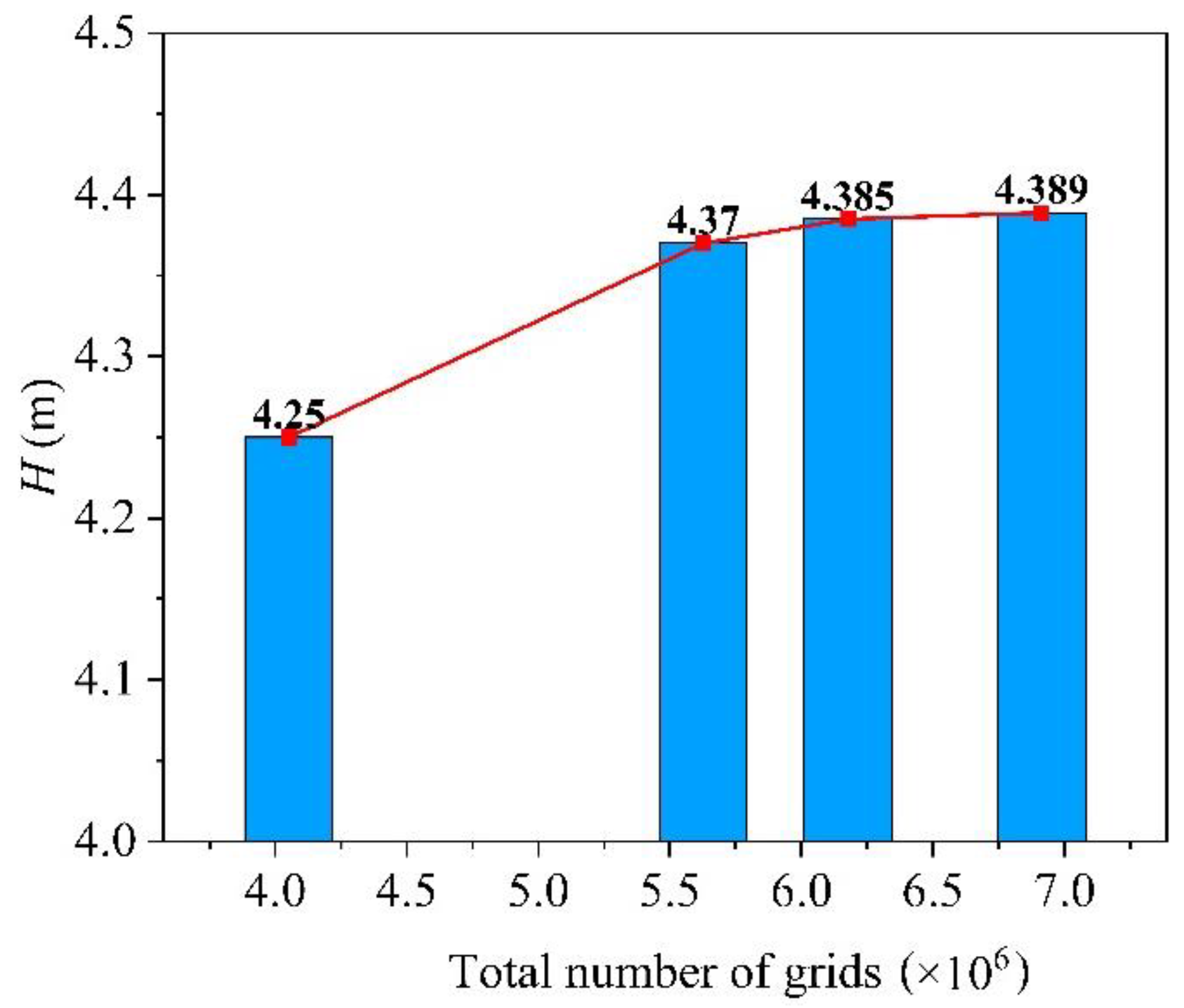

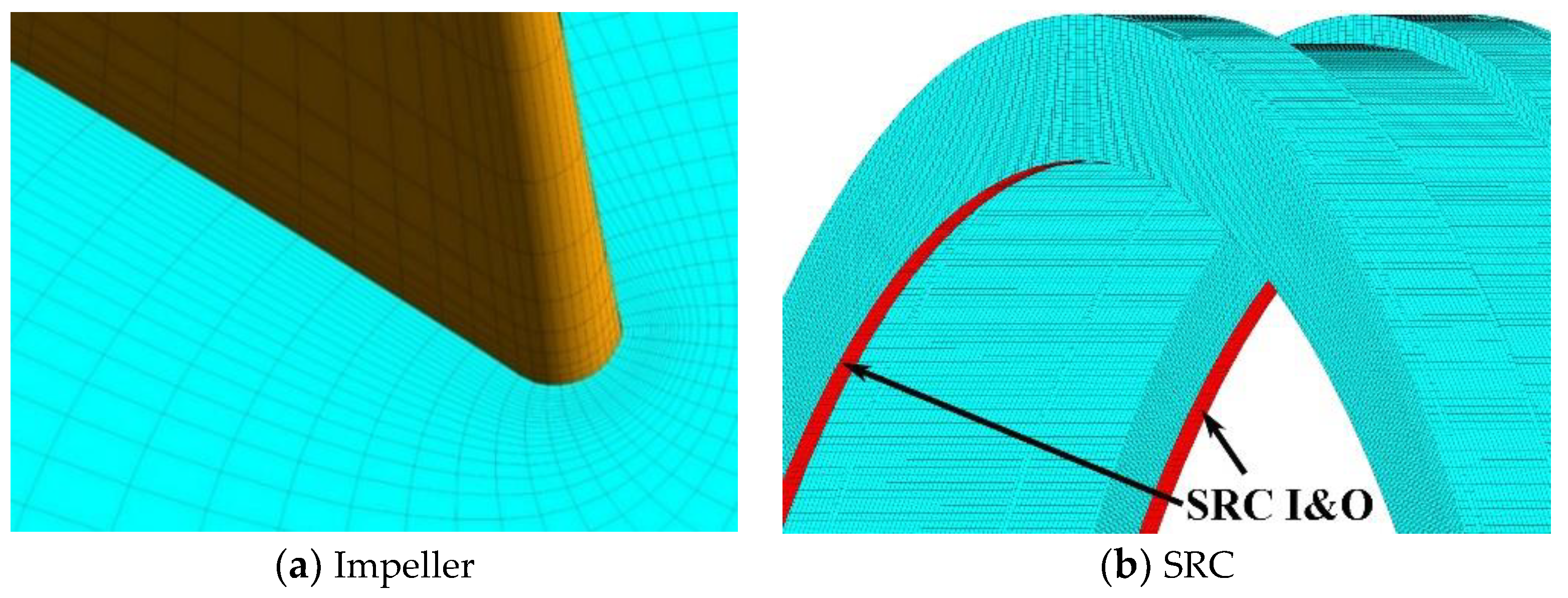



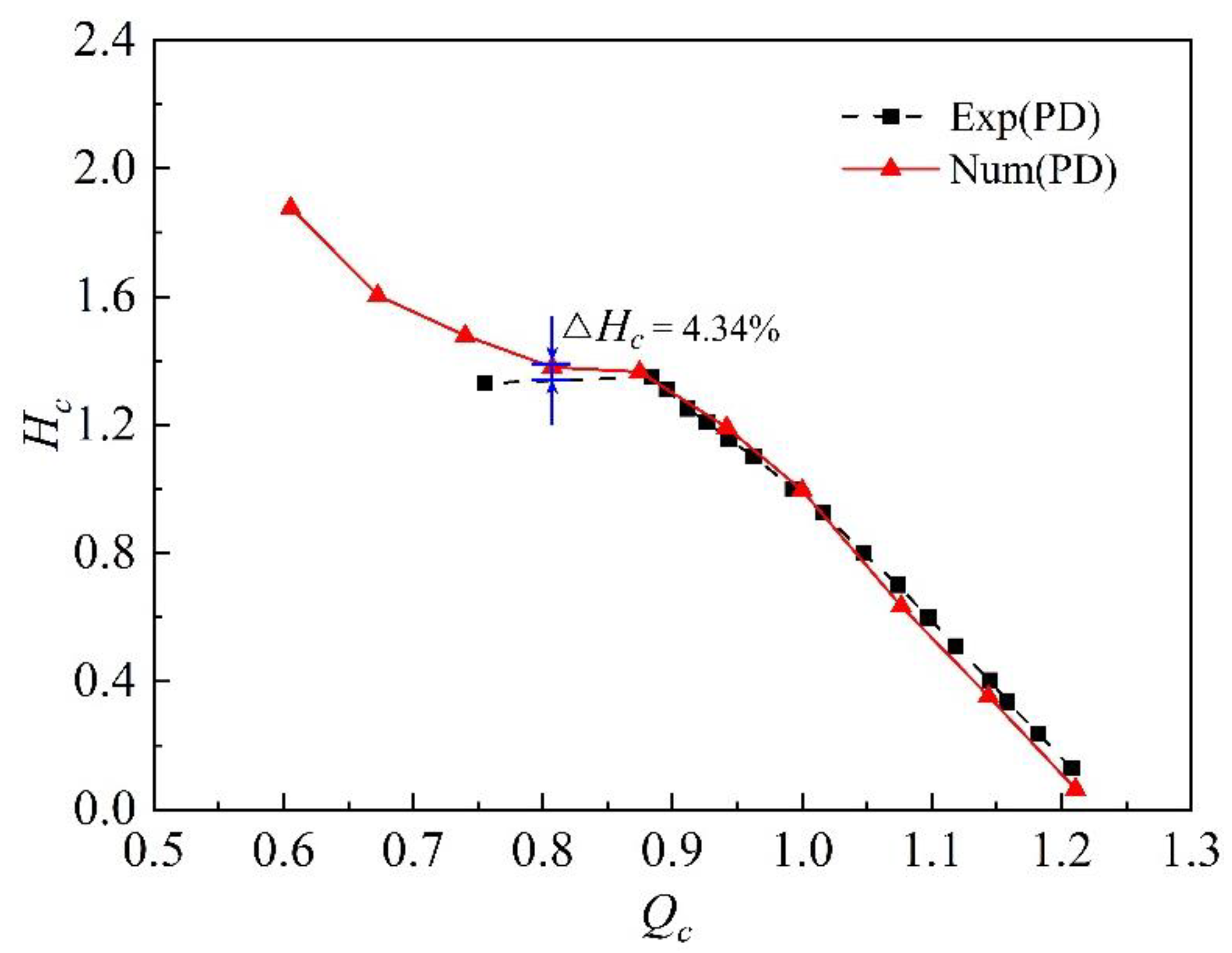
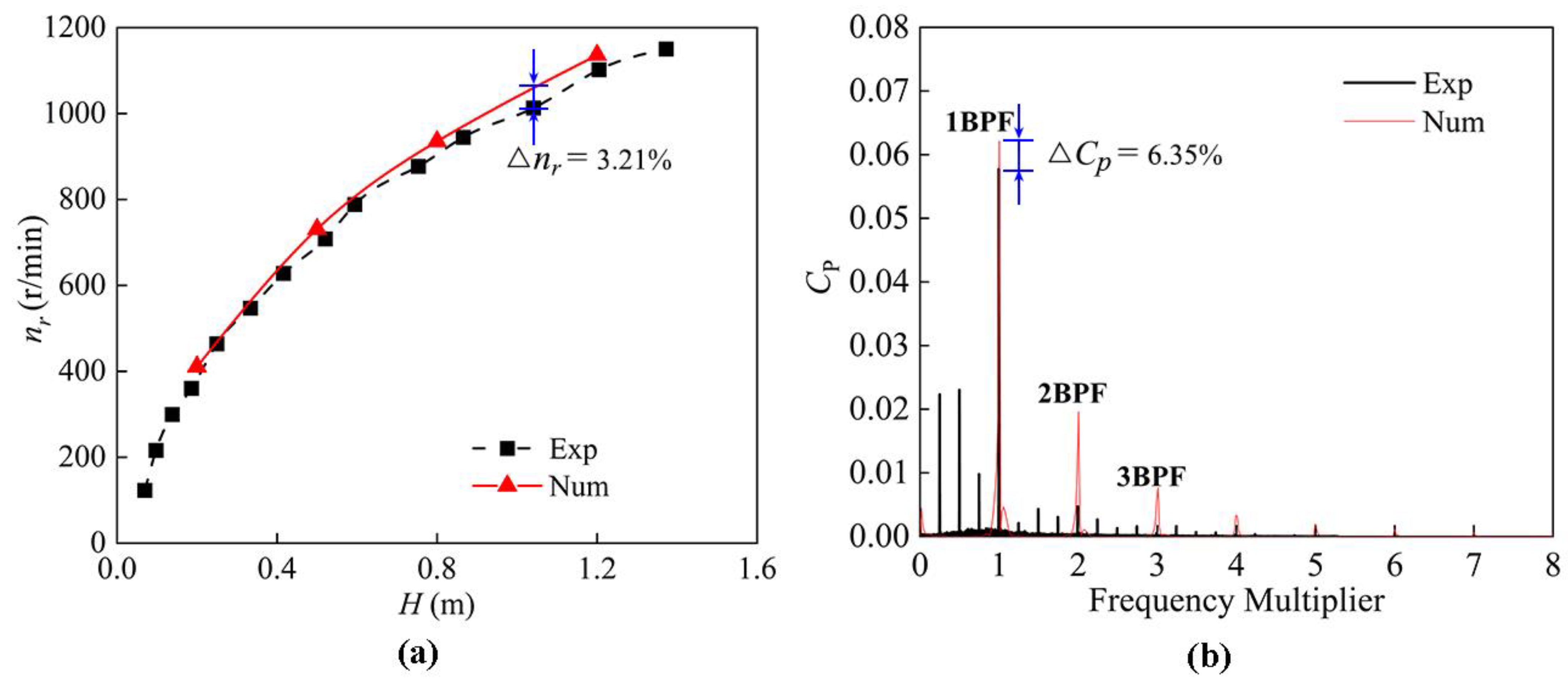
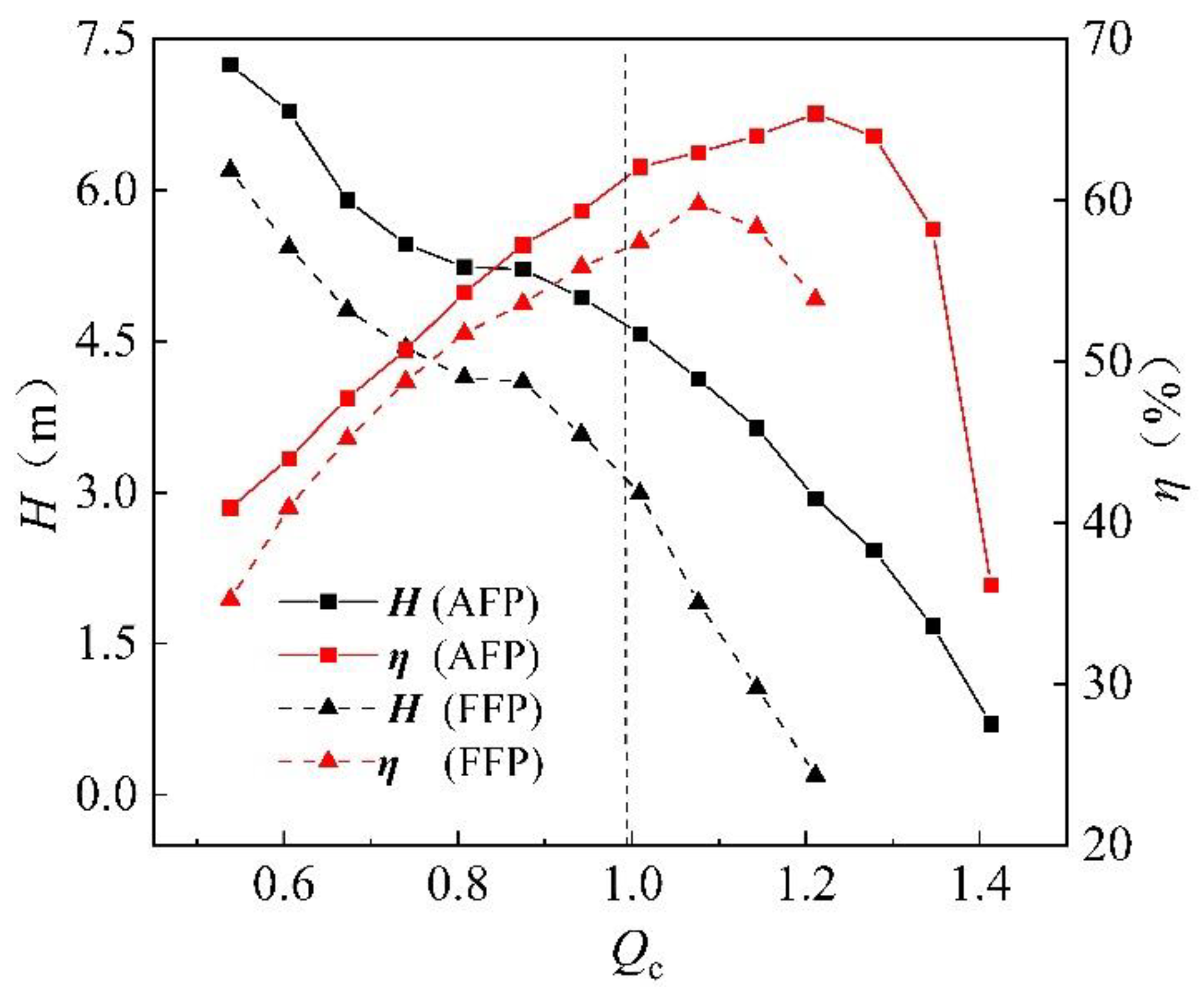
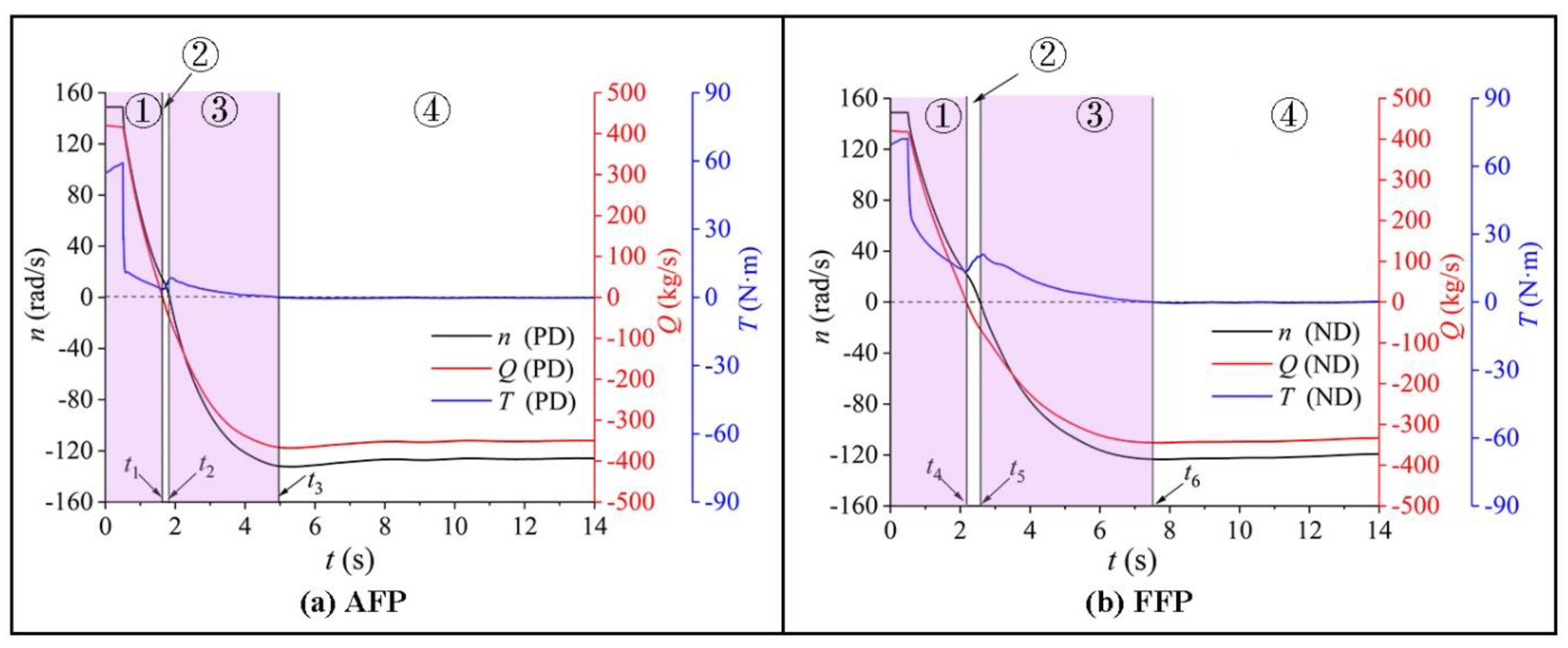
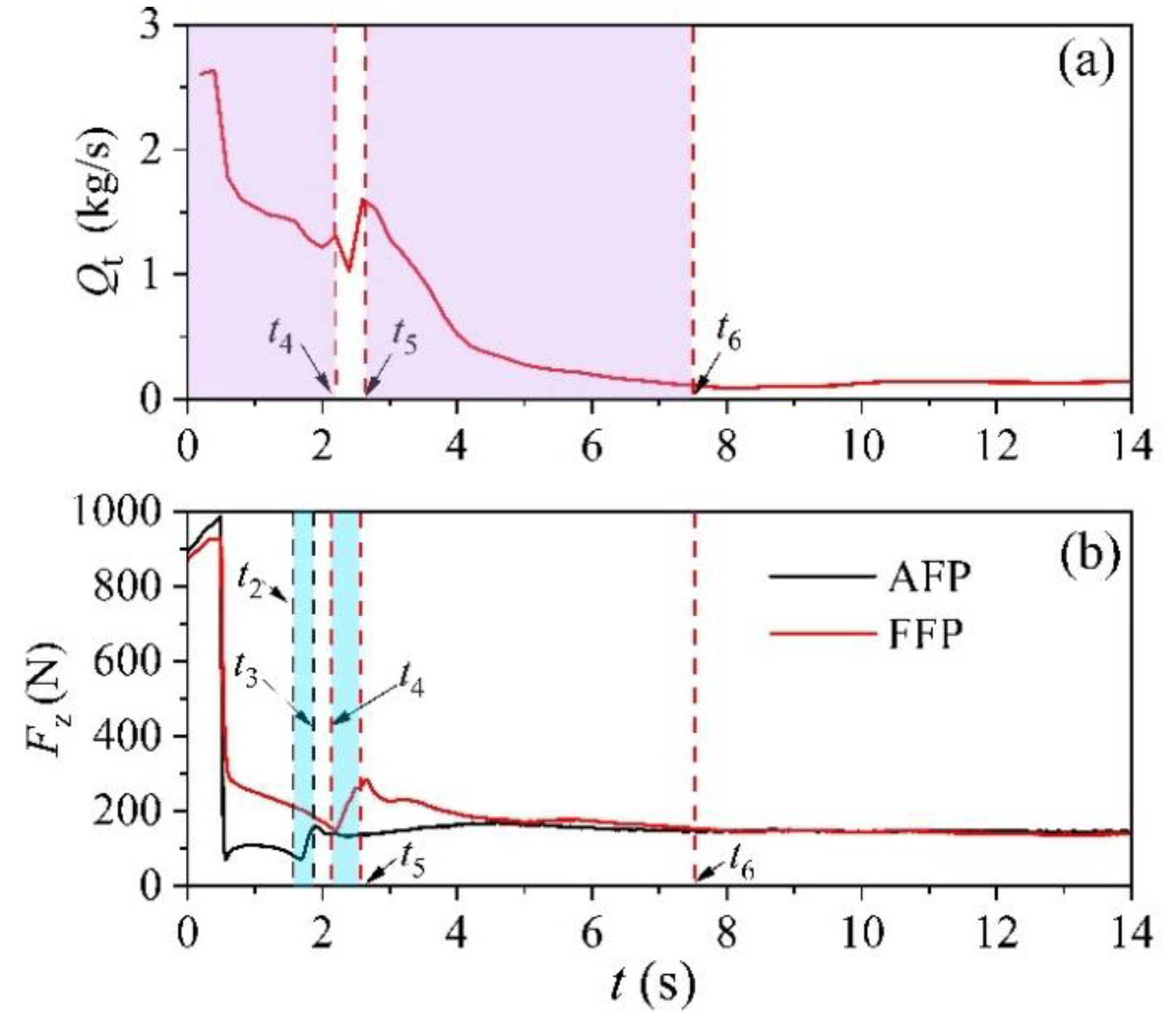
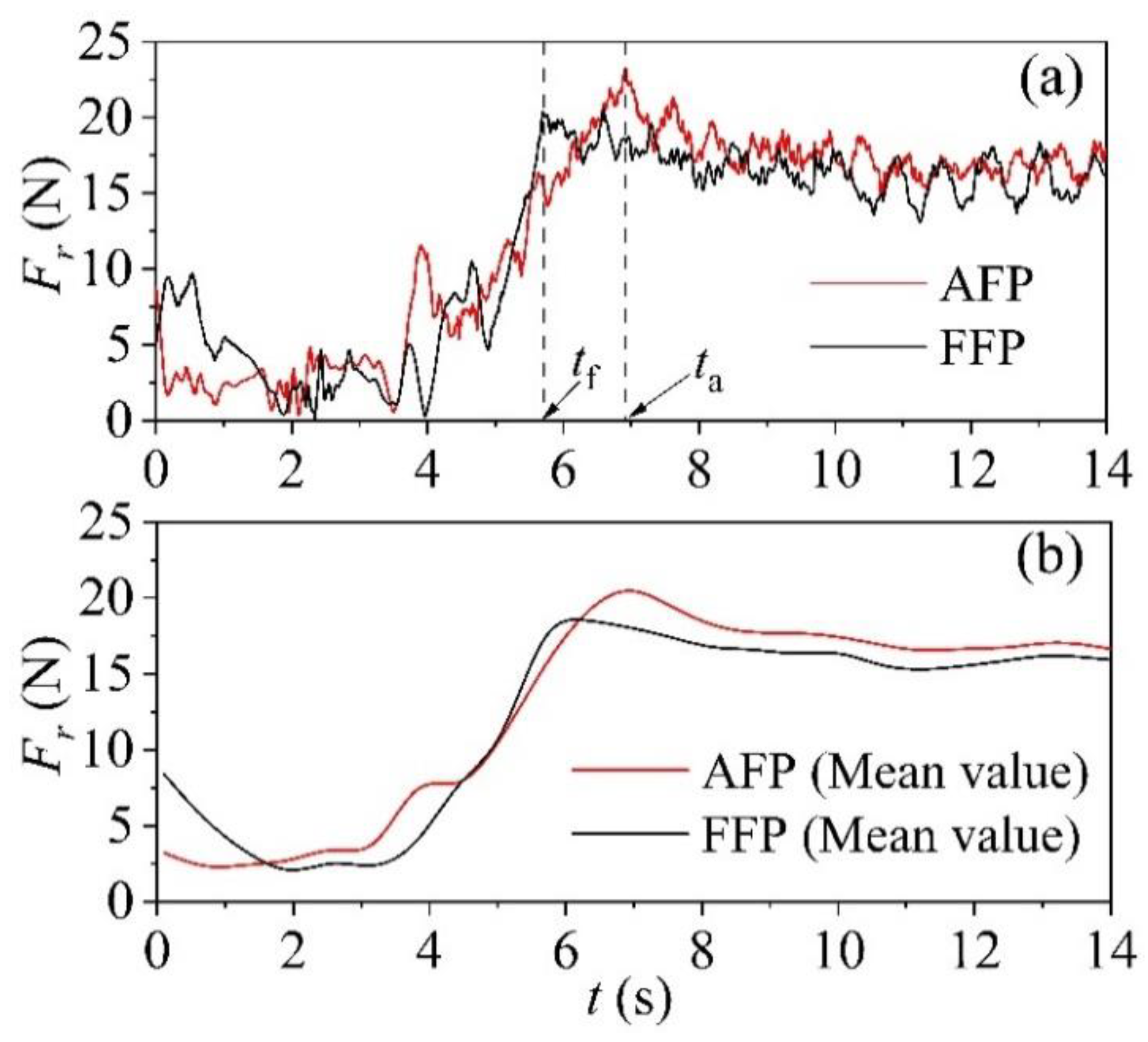
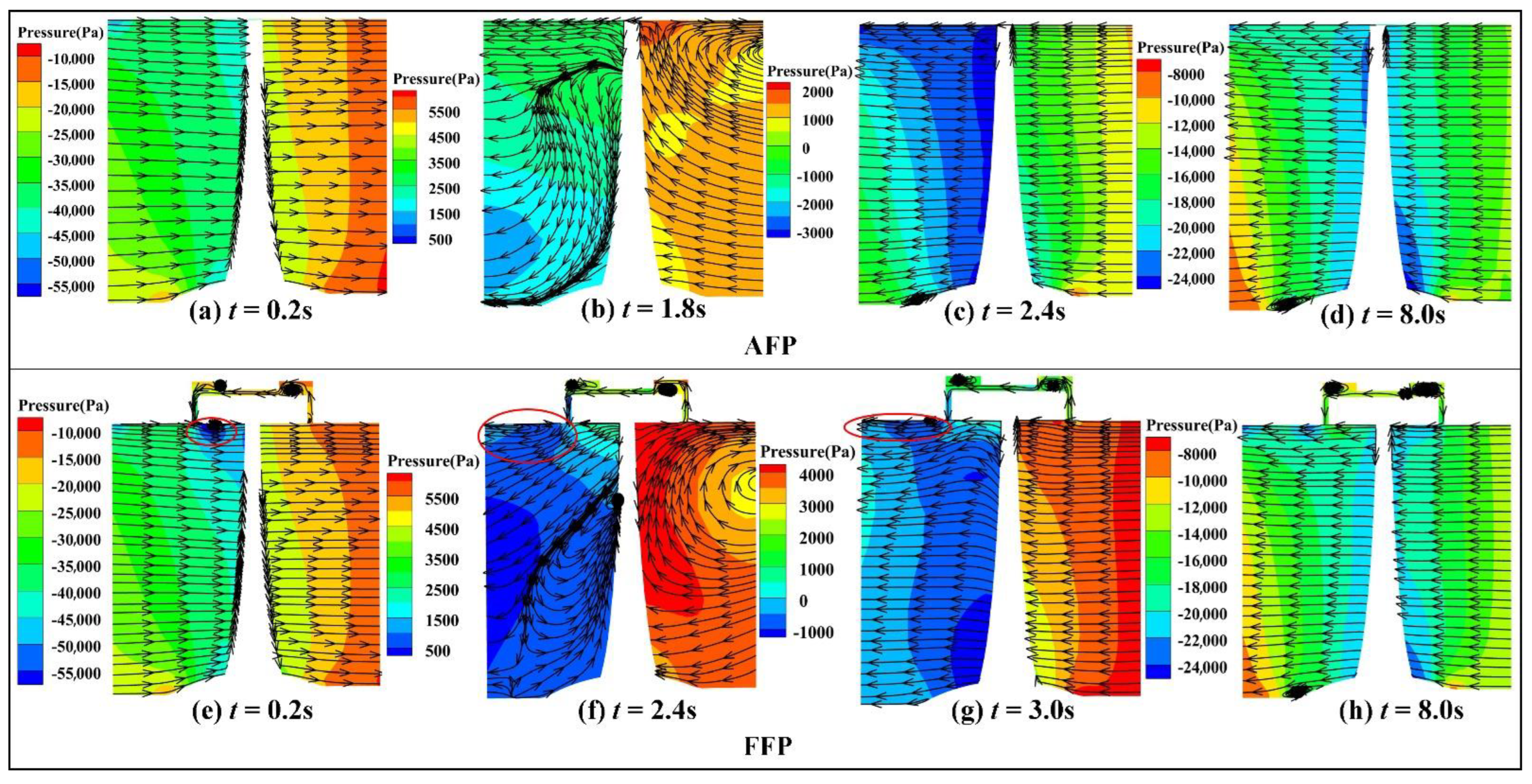
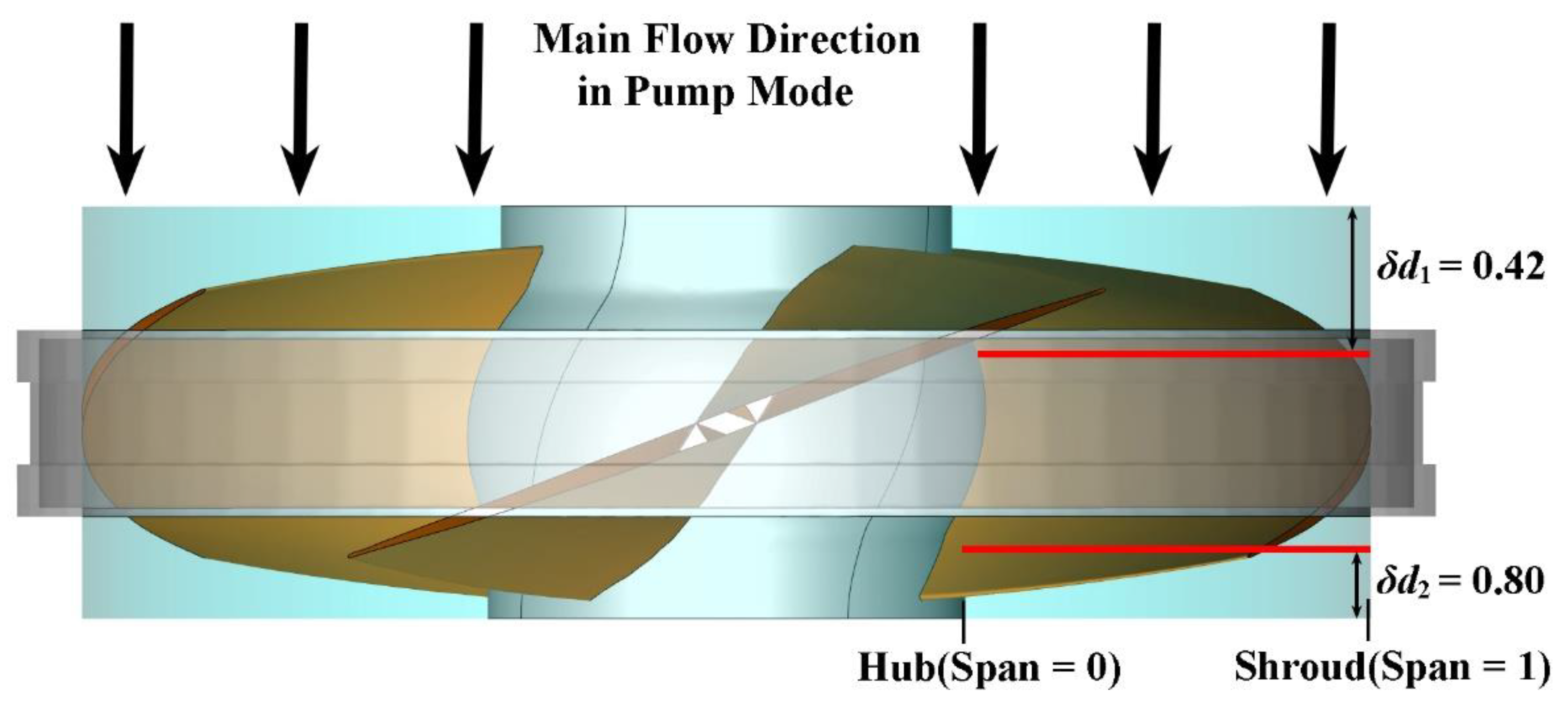
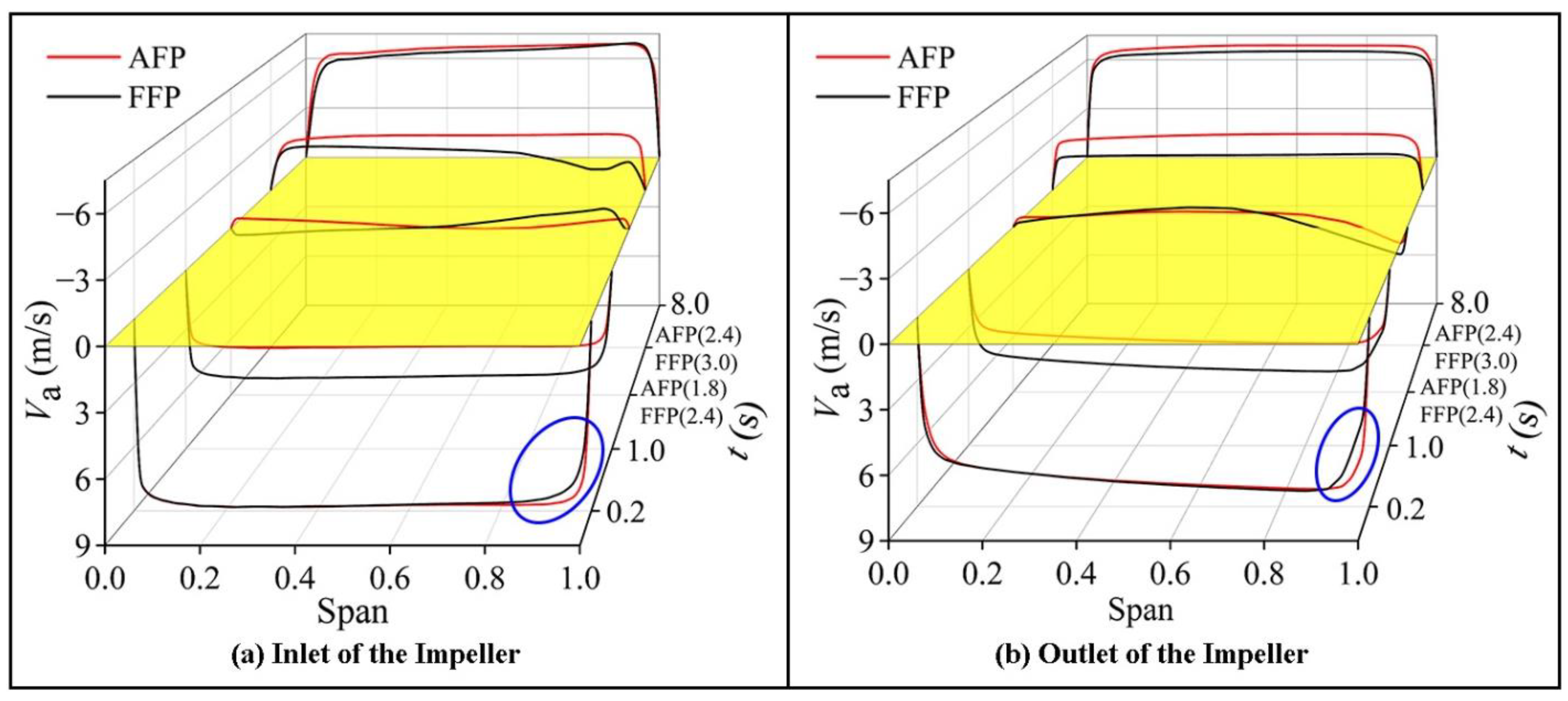
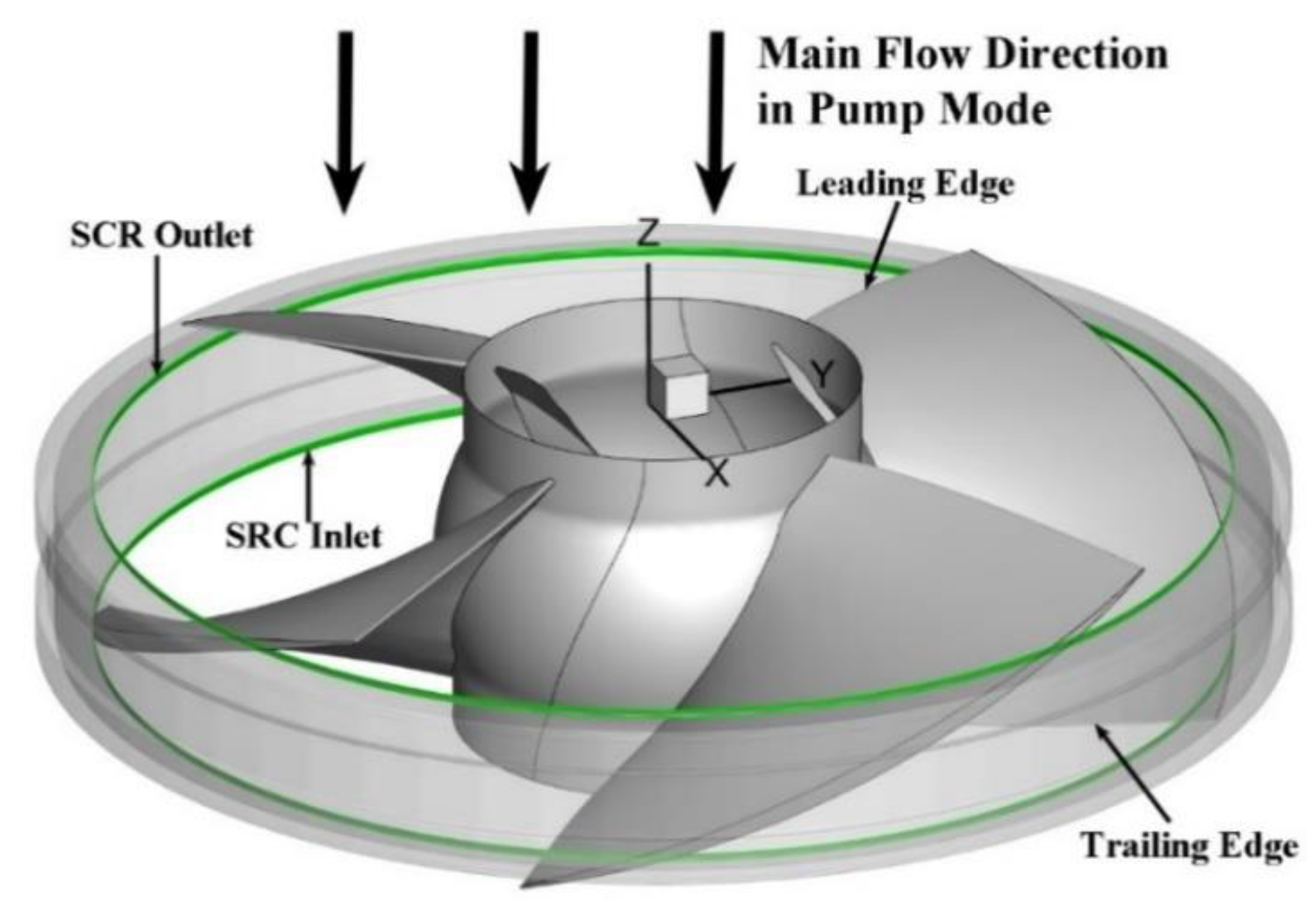
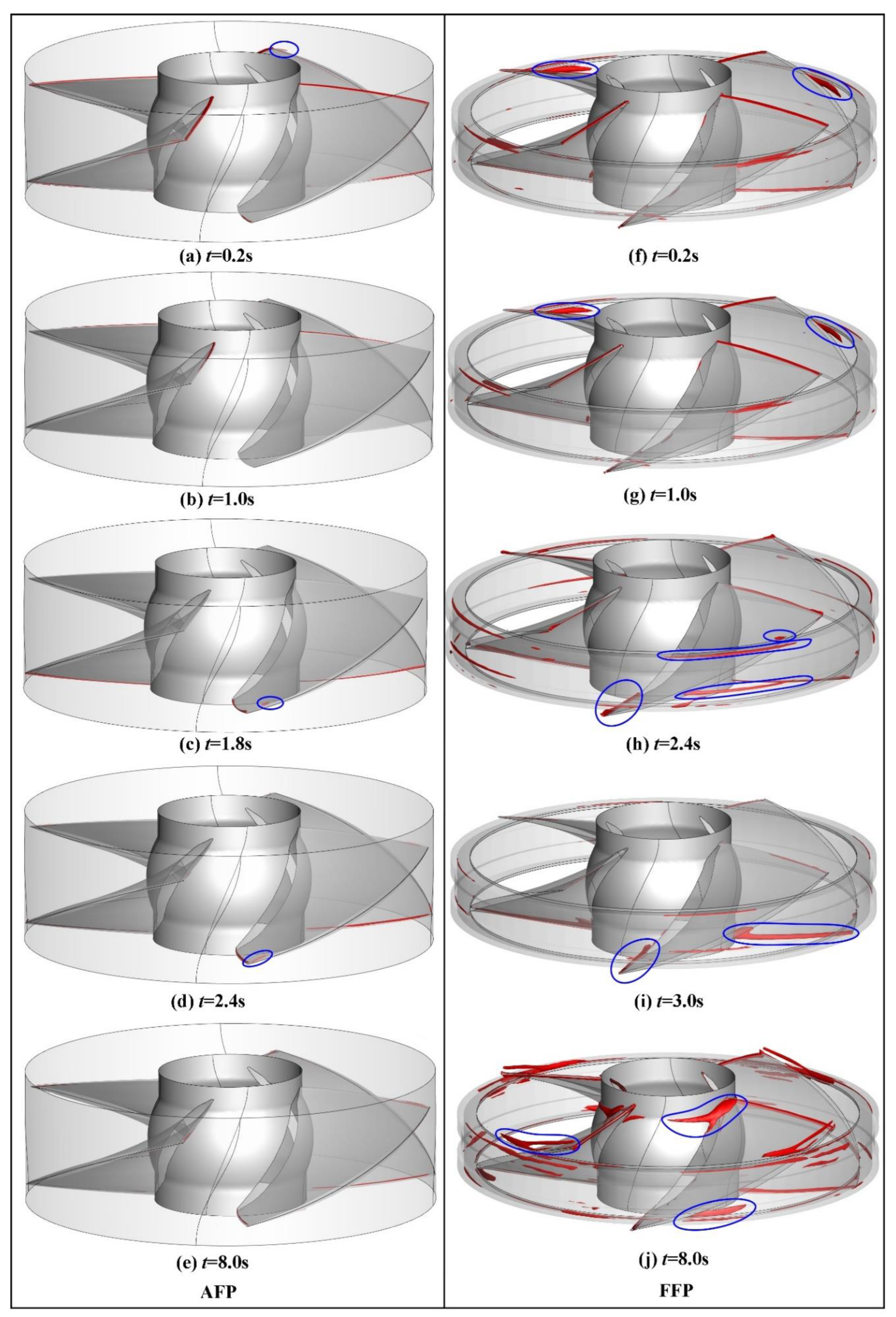
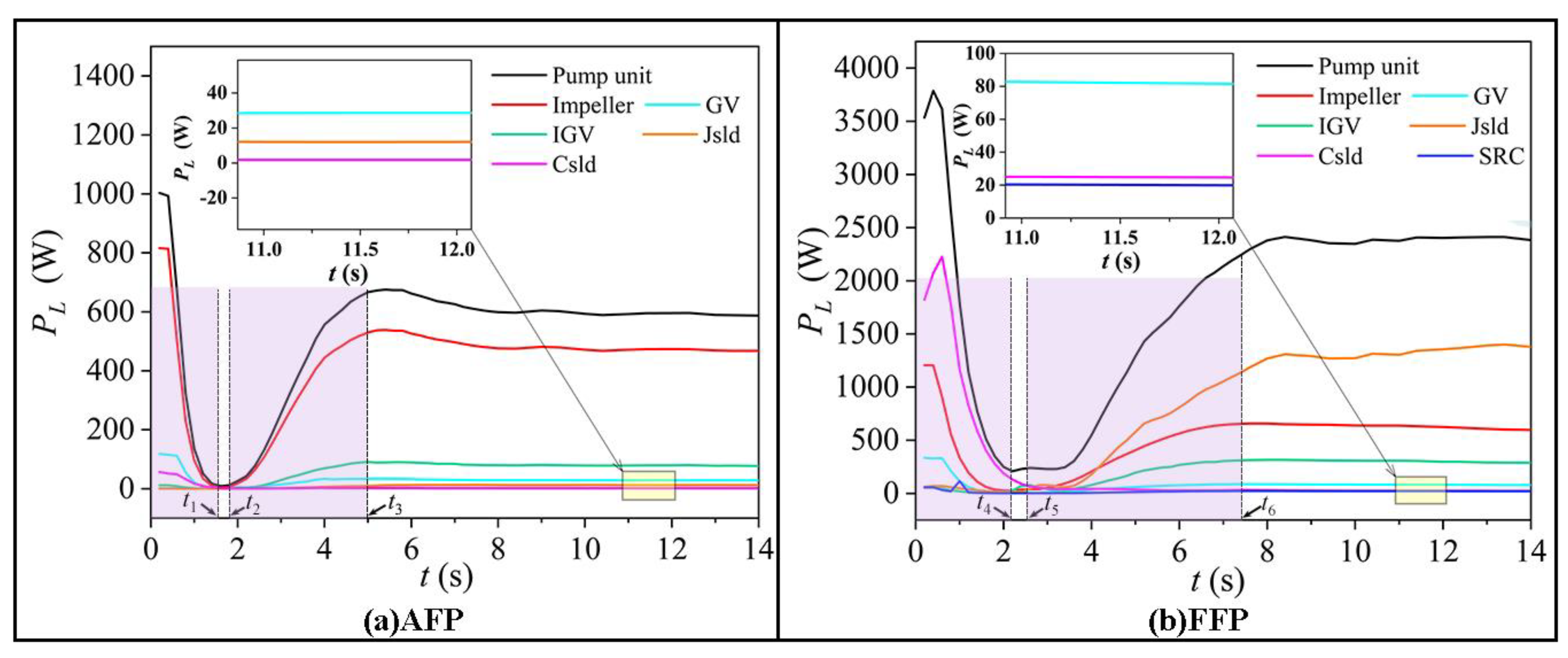


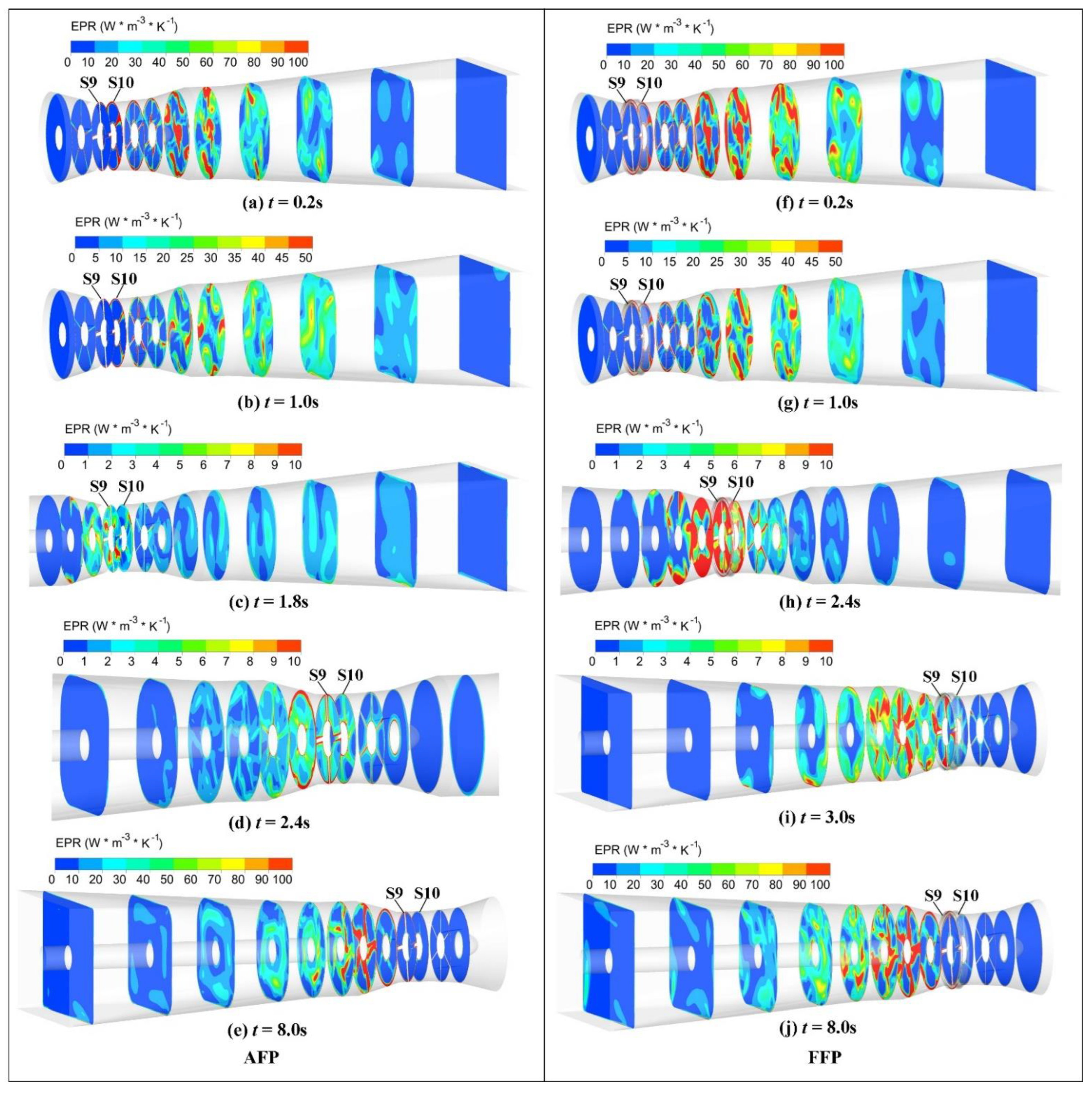
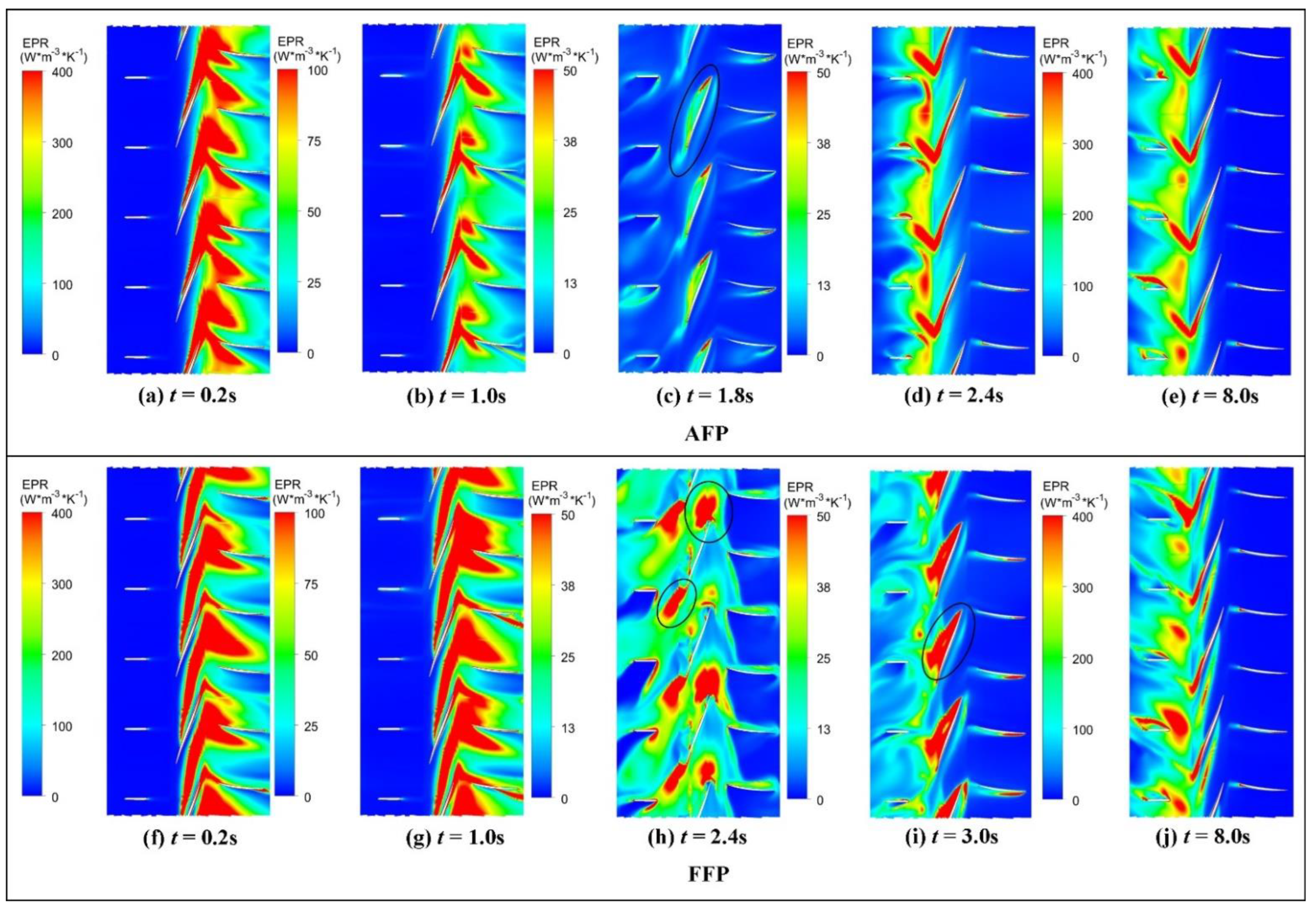
| Part | Grid Type | Node Number | Element Number |
|---|---|---|---|
| IGV | Hexahedral | 698,230 | 652,250 |
| GV | Hexahedral | 867,204 | 806,400 |
| Impeller | Hexahedral | 705,600 | 655,884 |
| Inlet channel | Hexahedral | 2,357,676 | 2,263,757 |
| Outlet channel | Hexahedral | 1,391,912 | 1,358,704 |
| GV diffuser | Hexahedral | 411,480 | 396,981 |
| SRC | Hexahedral | 904,032 | 773,508 |
| Total | Hexahedral | 7,336,134 | 6,907,484 |
Disclaimer/Publisher’s Note: The statements, opinions and data contained in all publications are solely those of the individual author(s) and contributor(s) and not of MDPI and/or the editor(s). MDPI and/or the editor(s) disclaim responsibility for any injury to people or property resulting from any ideas, methods, instructions or products referred to in the content. |
© 2023 by the authors. Licensee MDPI, Basel, Switzerland. This article is an open access article distributed under the terms and conditions of the Creative Commons Attribution (CC BY) license (https://creativecommons.org/licenses/by/4.0/).
Share and Cite
Jiao, H.; Shan, J.; Yang, G.; Wang, M.; Chen, S. Comparison of the Shutdown Transitions of the Full-Flow Pump and Axial-Flow Pump. J. Mar. Sci. Eng. 2023, 11, 2129. https://doi.org/10.3390/jmse11112129
Jiao H, Shan J, Yang G, Wang M, Chen S. Comparison of the Shutdown Transitions of the Full-Flow Pump and Axial-Flow Pump. Journal of Marine Science and Engineering. 2023; 11(11):2129. https://doi.org/10.3390/jmse11112129
Chicago/Turabian StyleJiao, Haifeng, Jilian Shan, Guorui Yang, Mengcheng Wang, and Songshan Chen. 2023. "Comparison of the Shutdown Transitions of the Full-Flow Pump and Axial-Flow Pump" Journal of Marine Science and Engineering 11, no. 11: 2129. https://doi.org/10.3390/jmse11112129
APA StyleJiao, H., Shan, J., Yang, G., Wang, M., & Chen, S. (2023). Comparison of the Shutdown Transitions of the Full-Flow Pump and Axial-Flow Pump. Journal of Marine Science and Engineering, 11(11), 2129. https://doi.org/10.3390/jmse11112129





